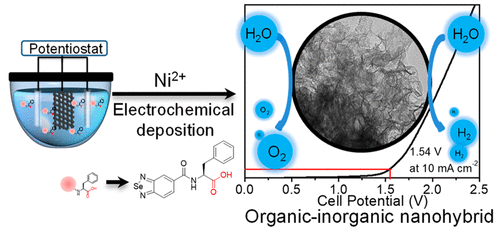Авторы: Rohit G. Jadhav, Devraj Singh, Кривошапкин П.В., Apurba K. Das

Abstract
Rational engineering of novel nanohybrid materials for sustainable and efficient energy conversion has gained extensive research interest. Cross-linked nanosheets of organic–inorganic nanohybrids (BSeF/Ni(OH)2) were fabricated by one-step reductive electrosynthesis and subsequently applied for electrocatalytic water electrolysis. The organic–inorganic nanohybrids consist of benzo[2,1,3]selenadiazole-5-carbonyl phenylalanine (BSeF) cross-linked with nickel ions (Ni-BSeF) and nickel hydroxides (Ni(OH)2), which provide abundant active sites and feasible charge transfer at the electrocatalytic interface. The resulting electrodeposited nanohybrid BSeF/Ni(OH)2 exhibits bifunctional electrocatalytic performance with 240 and 401 mV of overpotential at +100 and −100 mA cm–2 for oxygen evolution reaction (OER) and hydrogen evolution reaction (HER), respectively. The BSeF/Ni(OH)2 offers a longer electrocatalytic activity of 20 h for OER and HER at applied high current densities of +400 and −200 mA cm–2. Coupled with the high OER and HER activity, the two-electrode-based system of BSeF/Ni(OH)2 shows a low cell potential of 1.54 V at 10 mA cm–2. The electrocatalytic performance of Ni-BSeF and Ni(OH)2-based organic–inorganic nanohybrids provides an efficient way to develop a nanohybrid-based catalytic system for energy conversion.
https://doi.org/10.1021/acs.inorgchem.0c00227
Read Full: https://pubs.acs.org/doi/full/10.1021/acs.inorgchem.0c00227